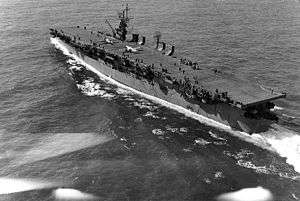USS Langley (CVL-27)
 USS Langley | |
| History | |
|---|---|
| Builder: | New York Shipbuilding Corporation |
| Laid down: | 11 April 1942 |
| Launched: | 22 May 1943 |
| Commissioned: | 31 August 1943 |
| Decommissioned: | 11 February 1947 |
| Fate: | Sold for scrapping |
| General characteristics | |
| Class and type: | Independence-class aircraft carrier |
| Displacement: | 11,000 tons |
| Length: | 622.5 ft (189.7 m) |
| Beam: |
|
| Draft: | 26 ft (7.9 m) |
| Speed: | 31 knots |
| Complement: | 1,569 officers and men |
| Armament: | 26 × 40 mm guns |
| Aircraft carried: | 45 aircraft |
USS Langley (CVL-27) was an 11,000-ton Independence-class light aircraft carrier that served the United States Navy from 1943 to 1947, and French Navy as the La Fayette from 1951 to 1963. Named for Samuel Pierpont Langley, American scientist and aviation pioneer, Langley received nine battle stars for World War II service. CVL-27 carried on the name and tradition of USS Langley (CV-1)(and was assigned hull classification symbol AV-3 on 11 April), the first US Navy aircraft carrier, which had been sunk on 27 Feb 1942.
Career
_and_others_enter_Ulithi.jpg)
Langley was built at Camden, New Jersey. She was originally ordered as the light cruiser USS Fargo (CL-85), but by the time her keel was laid in April 1942, she had been redesigned as an aircraft carrier, using the original cruiser hull and machinery. Commissioned in August 1943, Langley went to the Pacific late in the year and entered combat in World War II during the Marshall Islands operation in January–February 1944. During the next four months, her planes attacked Japanese positions in the central Pacific and western New Guinea. In June 1944, she took part in the assault on the Marianas and in the Battle of the Philippine Sea.
Langley continued her war role through the rest of 1944, participating in the Palaus Operation, raids on the Philippines, Formosa and the Ryukyus, and the Battle of Leyte Gulf. In January–February 1945, she was part of the Third Fleet's foray into the South China Sea, the first massed carrier attacks on the Japanese Home Islands and the invasion of Iwo Jima. More combat activity followed in March–May, as Langley's planes again hit targets in Japan and supported the Okinawa operation. Overhauled in the U.S. in June and July, she was en route back to the Pacific war zone when the war ended in August.
Following service transporting Pacific veterans home, Langley went to the Atlantic Ocean, where she carried out similar missions in November 1945 – January 1946. Inactive at Philadelphia during the remainder of 1946, the carrier was decommissioned there in February 1947.
Later career
Langley was taken out of "mothballs" early in 1951, refurbished and transferred to France under the Mutual Defense Assistance Program. After more than a decade of French Navy service as La Fayette, she was returned to the United States in March 1963 and was sold for scrap a year later.[1]
References
- The original version of this article based on US Navy public domain text.
- This article incorporates text from the public domain Dictionary of American Naval Fighting Ships. The entry can be found here.
External links
| Wikimedia Commons has media related to USS Langley (CVL-27). |
- navsource.org: USS Langley
- hazegray.org: USS Langley
- USS Langley at Nine Sisters Light Carrier Historical Documentary Project